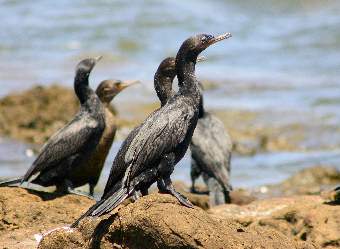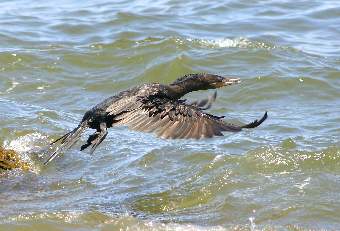
Picture of a group of Neotropic Cormorants near Piriapolis, Uruguay

Diagram of Cormorant's Bill

Picture of a Neotropic Cormorant Flying on a Fishing Expedition
|
The birds known as Cormorant and
Shag
together form the Phalacrocoracidae family of birds within the order Pelecaniformes.
Cormorants and Shags are middle to large, heavybuilt
sea-birds, who usually have dark plumage and a skin coloration in the face
generally around the eyes and extending to the bill, which varies from
bright blue to orange, red or yellow. Their size is between 45 cm
to 1 meter in length. They have long, supple necks, and a rather
long, wedge-shaped tail. The bill is long, thin and curved with a
sharp hook at the endpoint.
They are usually coastal birds, although some colonize
inland waters. For example the Great Cormorant (Phalacrocorax carbo) breeds
far from the coast. With the exception of the central Pacific islands,
Cormorants and Shags are common worldwide. They and are particularly
plentiful in New Zealand and the western coast of the USA - cormorants
in those areas are among the most splendidly dressed in their dark feathered
outfits.
Fishing Abilities of the Cormorant
All cormorants are good fishers, eating around 500
grams of fish a day. They can dive under water for more than a minute,
reaching depths of around 10 metres. Below the water they swim by
using paddle movements of their feet which have a webbed membrane between
the four toes. After fishing, cormorants dry their plumage
by spreading their wings wide in the sun. This attitude is so typical for
cormorants that even inexperienced birdwatchers can recognize these birds
from a distance. The habit is to be attributed to the fact that their plumage
is not water resistant, a characteristic unusual for water birds, but which
allows them to sink and dive with ease.
Humans have themselves in the past made use of
the diving and fishing abilities of the cormorant. This traditional
method of fishing can still be observed in Inuyama in Yangshuo on the borders
of the river Li in China.
Social and Nesting Habits
Cormorants are social birds and usually live in colonies,
located on small stony islands, cliffs or trees. When a flock of
cormorants are flying together, they adopt a V formation, similar to many
other large birds.
The nest is usually a piled up construction made
from grasses, seaweed and wood. The two to four eggs, which a clutch of
eggs normally contains, have a pale-blue coloring. The incubation period
lasts about 27 to 30 days and both parents birds take part in incubating
the eggs. The chicks receive their food from the throat of the parents
birds. After 5 to 6 weeks the cormorant chicks leave their nest, and become
independent after 10 to 12 weeks. Normally only one brood is produced
in a year.
|





